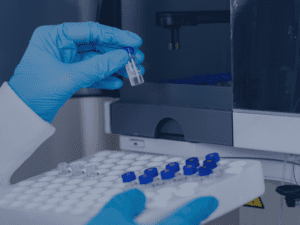Overcoming Operational Challenges with AI Drug Discovery
While computer-assisted drug discovery has been around for 50 years, the need for advanced computing tools has never been so crucial.
 Today, machine learning is proving invaluable in managing some of the intricacies of R&D and powering breakthroughs thanks to its ability to process millions of data points in mere seconds.
Today, machine learning is proving invaluable in managing some of the intricacies of R&D and powering breakthroughs thanks to its ability to process millions of data points in mere seconds.
Of course, AI drug discovery and development tools have their own complex operational demands. Ensuring their integration, operation, and security requires high-performance computing and tools that help manage and make sense of massive data output.
Aligning Biochemistry, AI, and system efficiency
The process of creating and refining pharmaceuticals and biologics is becoming more complex, precise, and personalized, largely due to the robust toolkit of artificial intelligence. As a result, combining complex scientific disciplines, AI-aided tools, and expansive IT infrastructure has come to pose some interesting challenges.
Now, drug discovery and development teams require tools and AI that can:
- Optimize data and applicable storage and efficiently preprocess massive molecular datasets.
- Support high-throughput screening as it sifts through millions of molecular predictions.
- Enable rapid and accurate prediction of molecular attributes.
- Integrate large and diverse datasets from clinical trials, genomic insights, and chemical databases.
- Scale up as computational power as demands surge.
Challenges in Bio-IT for drug discovery and development
Drug discovery and development calls for a sophisticated toolset. The following challenges demonstrate the obstacles such tools must overcome.
- The magnitude and intricacy of the molecular datasets needed to tackle the challenges of drug discovery and development require more than storage solutions. These solutions must be tailored to the unique character of molecular structures.
- High-throughput screening (HTS)—a method that can rapidly test thousands to millions of compounds and identify those that may have a desired therapeutic effect—also requires immense processing power. Systems must be capable of handling immediate data feeds and performing fast, precise analytics.
- Predicting attributes for millions of molecules isn’t just about speed; it’s about accuracy and efficiency. As a result, the IT infrastructure must be equipped to handle these instantaneous computational needs, ensuring there are no delays in data processing, which could bottleneck the research process.
- The scalability issue extends far beyond capacity. Tackling this requires foresight and adaptability. Planning for future complexities in algorithms and computation means pharma teams need a robust and adaptive infrastructure.
- Integrating data into a holistic model poses significant challenges. Teams must find ways to synthesize clinical findings, genomic insights, and chemical information into a unified, coherent data model. This requires finding tech partners with expertise in AI-driven systems and data management strategies; these partners should also recognize and address the peculiarities of each domain, all while providing options for context-driven queries.
As we can see, high-level Bio-IT isn’t just an advantage; it’s a necessity. And it’s one that requires the right infrastructure and expertise from an experienced IT partner.
Mastering the Machine Learning Workflow
 Bridging the nuances of drug discovery with the technicalities of artificial intelligence demands specialized knowledge, including:
Bridging the nuances of drug discovery with the technicalities of artificial intelligence demands specialized knowledge, including:
- Machine learning algorithms. Each drug discovery dataset has unique characteristics, and the AI model should mirror these idiosyncrasies. Initial testing in a sandbox environment ensures scalability and efficiency before amplification across larger datasets.
- Data preprocessing. High-quality data drives accurate predictions. Effective preprocessing ensures datasets are robust, balanced, capable of interpolating gaps, and free from redundancies. In the pharmaceutical realm, this is the bedrock of insightful machine-learning models.
- Distributed computing. When handling petabytes of data, traditional computational methods may falter. Enter distributed computing. Platforms like Apache Spark enable the distributed processing essential for the seamless analysis of massive datasets and drawing insights in record time.
- Hyperparameter tuning. For pharma machine learning models, tweaking hyperparameters is key to the best performance. The balancing act between trial-and-error, Bayesian optimization, and structured approaches like grid search can dramatically impact model efficiency.
- Feedback mechanisms. Machine learning thrives on feedback. The tighter the loop between model predictions and real-world validations, the sharper and more accurate the predictions become.
- Model validation. Ensuring a model’s robustness is critical. Cross-validation tools and techniques ensure that the model generalizes well without losing its specificity.
- Integration with existing Bio-IT systems. Interoperability is key. Whether through custom APIs, middleware solutions, or custom integrations, models must be seamlessly woven into the existing IT fabric.
- Continuous model training. The drug discovery landscape is ever-evolving. Models require a mechanism that constantly feeds new insights and allows them to evolve, adapt, and learn with every new dataset.
Without the right Bio-IT infrastructure and expertise, AI drug discovery cannot reach its full potential. Integrating algorithms, data processing, and computational methods is essential, but it’s their combined synergy that truly sparks groundbreaking discoveries.
Navigating Bio-IT in drug discovery
As the pharmaceutical industry advances, machine learning is guiding drug discovery and development to unprecedented heights through enabling the creation of sophisticated data models.
By entrusting scientific computing strategies and execution to experts who understand the interplay between research, technology, and compliance, research teams can remain focused on their primary mission: groundbreaking discoveries.
Get in touch with our team if you’re ready to start a conversation about harnessing the full potential of Bio-IT for your drug discovery endeavors.
 Today, machine learning is proving invaluable in managing some of the intricacies of R&D and powering breakthroughs thanks to its ability to process millions of data points in mere seconds.
Today, machine learning is proving invaluable in managing some of the intricacies of R&D and powering breakthroughs thanks to its ability to process millions of data points in mere seconds. Bridging the nuances of drug discovery with the technicalities of artificial intelligence demands specialized knowledge, including:
Bridging the nuances of drug discovery with the technicalities of artificial intelligence demands specialized knowledge, including: